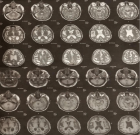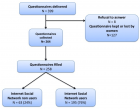About University of Ibadan
University of Ibadan
Articles by University of Ibadan
Comparison of selected lower limb biomechanical variables between university of ibadan sportsmen with and without patellofemoral pain syndrome
Published on: 16th August, 2019
OCLC Number/Unique Identifier: 8235051929
Patellofemoral pain syndrome is common among athletes who participate in jumping, running and pivoting sports. The aim of this study was to compare selected lower limb biomechanical variables between University of Ibadan students (athletes) with and without patellofemoral pain syndrome.
The research design for this study was a case control survey and a purposive sampling technique was used to recruit participants. Two hundred and twenty two (191(85.8%) males and 31 (14.2%) females) sportsmen participated in this study. The participants’ age was between 20-29 years. Fourty sportsmen tested positive to Clarke’s test while 27 sportsmen tested positive to Eccentric step test. Measurements of static quadriceps angle, hamstring tightness and navicular height were taken for all participants.
Data were analyzed using descriptive statistics of mean, standard deviation, percentages and inferential statistics of Independent ‘t’ test.
The mean lower limb biomechanical variables of participants with patellofemoral pain syndrome were 13.18 ± 2.37°, 106.46 ± 16.11° and 1.21 ± 0.61 cm while those without were 13.65 ± 2.46°, 128.95 ± 25.36° and 1.03 ± 0.58 cm for static quadriceps angle, hamstring tightness and navicular height respectively. There was no significant difference (p > 0.05) in selected lower limb biomechanical variables between participants with and without patellofemoral pain syndrome.
In conclusion there was no significant difference in static quadriceps angle, hamstring tightness and ankle pronation between participants with and without patellofemoral pain syndrome. It was recommended that PFPS development is probably multifactorial with other functional disorders of the lower extremity apart from the selected variables.
Burden of hearing loss in Subsaharan Africa: Snapshot from an ENT clinic in Nigeria
Published on: 31st December, 2019
OCLC Number/Unique Identifier: 8512989994
Background: Disabling hearing loss is a prevalent public health issue, with significant impact on patients’ communication. The disability associated with hearing loss depends on the severity of the hearing loss. There are limited rehabilitative measures in resource challenged environment. This study assesses the incidence, the factors for hearing impairment and the management outcome.
Methods: A descriptive three-year chart review of patients managed for hearing loss in a tertiary health center in a developing country. The data collected include demographic data, clinical presentation and risk factors for hearing loss, audiometric reports, rehabilitative measures and management outcome.
Results: The patients with ear symptoms managed within the study period were 1350, of whom 498 (36.8%) had hearing loss of varying degrees. These included 145 (29.1%) males and 353 (70.9%) females with male to female ratio of 1:2.4. The age ranged from 8 to 80 years (median age of 35.7). Disabling hearing loss in the better-hearing ear occurred in 216 (43.4%) of cases. Increasing age and chronic supportive otitis media were associated with disabling hearing loss. The hearing thresholds improved with hearing aids and ear surgical procedures; nonetheless the patients’ rehabilitation was impaired by limited resources.
Conclusion: There is poor rehabilitation of people with hearing loss, though management outcome is commendable in a few of them. Health education will reduce the risk factors for disabling hearing loss and improved rehabilitative measures are needed for these individuals.
Postgraduate students’ perception of the educational environment of a wet lab training in Neurological Surgery Division, UCH, Ibadan
Published on: 12th December, 2019
OCLC Number/Unique Identifier: 8601588152
Objective: The importance of understanding the perceptions of medical students to their training environment cannot be overemphasized. The study evaluated the wet lab training organized for Senior Registrars in the Neurosurgery, Division of the University College Hospital, Ibadan.
Aim: The purpose of this study is to assess the experiences of postgraduate students during wet-lab training with the aim of improving the course content and introducing evidence-based and student-centered changes.
Methodology: The study made use of a cross-sectional design and data were collected using the qualitative research approach. Information was elicited from all the Senior Registrars who participated in the training through in-depth interviews.
Result: All the postgraduate students who participated in the training were satisfied with the course content and the method of delivery appropriated during the training. They also found it relevant to their practice. However, certain shortcomings were observed such as high cost of training, poor standard of equipment/tools, tight work schedule and short training duration.
Conclusion: Hands-on training plays an important role in enhancing the quality of care and high performance in health-care service delivery. The shortcomings and suggestions for improving future trainings as reported by the residents should be addressed in order to maximize the gains of the hands-on training experience
Radionuclide contents in yam samples and health risks assessment in Oguta oil producing locality Imo State Nigeria
Published on: 5th April, 2021
OCLC Number/Unique Identifier: 9024345201
Oguta LGA is surrounded by 44 oil wells located around different communities. Preliminary investigations indicated that crude wastes were not properly managed and oil spillage occurred regularly in the LGA. Therefore, assessment of both radionuclide contents in yam matrix and health risks in Oguta was carried out to determine possible radiological health risks associated with improper management of crude wastes, and also evaluate haematological health profile in the LGA for future reference and research. A well calibrated NaI (Tl) detector was deployed for the radiological investigation, and about 5 ml of blood samples were collected from 190 participants each from Oguta and the control LGAs for haematological assessment. Mean activity concentrations due to 40K, 226Ra and 232Th in yam samples from Oguta LGA were 189.99 ± 59.14 Bqkg-1, 23.75 ± 5.69 Bqkg-1 and 30.99 ± 9.51 Bqkg-1, respectively while mean activity concentrations due to natural radionuclides in yam samples from control LGA were 110.40 ± 78.53 Bqkg-1, 10.12 ± 3.34 Bqkg-1 and 18.39 ± 8.74 Bqkg-1 for 40K, 226Ra and 232Th, respectively. Committed effective dose equivalent values in Oguta and the control LGAs were 704.95 ± 183.30 μSvy-1 and 403.65 ± 172.19 μSvy-1, respectively which are less than world average value of 1.1 mSvy-1. Crucially, one-way ANOVA at α0.05 has indicated that effects of radiological parameters due to natural radionuclides in yam from Oguta are significantly different from effects of radiological parameters due to natural radionuclides in yam from the control LGA. However, the percentage contributions of natural radiation exposures to incidence of cancer in Oguta and the control LGAs are just 1.7% and 1.4%, respectively, and haematological investigations have shown that overall health of the communities in the study LGAs has not been compromised due to environmental and human factors. Hence, natural radioactivity may have been elevated in Oguta but the concentration levels are not yet alarming. Radiological health risks could result from consistent exposure to those natural radionuclides in the long term.
Utilization of midwives service scheme among women farmers in Southwestern Nigeria
Published on: 7th December, 2020
OCLC Number/Unique Identifier: 8872657832
Maternal mortality accounts for most deaths in agrarian communities of Nigeria due to poor access to midwives services and inadequate Skilled Birth Attendants (SBAs). The Midwives Service Scheme (MSS) was established to engage more SBAs and advocate better utilization of pre and post-natal care services. Studies have focused on maternal mortality reduction, however, information on underlying factors that predispose MSS target beneficiaries to its utilization is scarce. Therefore, utilization of MSS among women farmers in southwestern Nigeria was investigated. A four-stage sampling procedure was used. Three states from southwestern states (Oyo, Ogun and Ekiti) were randomly selected. Thereafter, ten Local Government Areas (LGAs) from eighteen LGAs that adopted MSS programme in the selected states were sampled. Also, 30% of the MSS facilities in the sampled LGAs were selected, resulting in 13 MSS facilities. Proportionate sampling technique was used to select 20% of registered women farmers in the selected 13 MSS facilities to give 207 respondents. Interview schedule was used to collect data on respondents’ socioeconomic characteristics, Maternal Health Information Sources (MHIS), Maternal Health Information Seeking Behavior (MHISB) and utilization of MSS. Data were analyzed using descriptive and inferential statistics. About (55.6%) of the respondents had formal education. MHISB and effectiveness of MSS was rated low by 53.2% and 55.6% of the respondents, respectively. MSS was moderately utilized by 64.7% of the respondents. The MSS utilization was 49.24 ± 11.39 (Oyo), 45.08 ± 9.28 (Ogun) and 44.00 ± 10.71 (Ekiti). Respondents’ education (χ2 = 12.85), family size (r = 0.02), monthly income (r = 0.48) related positively and significantly (r = 0.27) to MSS utilization.
Perceived causes and prevention of catheter-associated urinary tract infections among spinal cord injured patients
Published on: 27th November, 2019
OCLC Number/Unique Identifier: 9272371774
Catheter-associated urinary tract infection (CAUTI) is among the most common nosocomial infections especially in acute care settings. Its economic and unanticipated health implications make it burdensome for the healthcare providers and patients. The paper examined the perceived causes and mode of preventing urinary tract infections in patients with spinal cord injury. Qualitative research approach was utilized; the study site was a Tertiary Hospital in Nigeria. Eight (8) in-depth interviews (IDI) were conducted with healthcare providers managing patients with spinal cord injured in the hospital. The major risk factors causing urinary tract infection identified include financial problems, organization of care, human error, hospital environment and patient-related factors. To prevent urinary tract infections among patients in the hospital, a number of suggestions were made by the participants such as training of caregivers and educating patients and relations. The authors concluded that the incidence of CAUTI could be reduced in the hospital if the opinions of stakeholders are fairly considered.
The Synergistic Effect of Combined Linagliptin and Metformin Improves Hepatic Function in High-fat Diet/Streptozotocin-induced Diabetic Rats
Published on: 2nd June, 2025
Background: Monotherapy for liver dysfunction in diabetes is less effective. This study investigated the effect of combined linagliptin and metformin therapy on liver function in diabetic rats. Methods and materials: Sixty-four mature male (200-300 g) Wistar rats were used. Streptozotocin (35 mg/kgb.wt) was repeatedly injected intraperitoneally to induce diabetes. The rats were grouped into eight groups (n = 8). Group I: control; Group II: control + 10 mg/kgb.wt linagliptin; Group III: control + 200 mg/kgb.wt metformin; Group IV; control + 10 mg/kgb.wt linagliptin + 200 mg/kgb.wt metformin; Group V: diabetic; Group VI: diabetic + 10 mg/kgb.wt linagliptin; Group VII: diabetic + 200 mg/kgb.wt metformin; Group VIII: diabetic + 10 mg/kgb.wt linagliptin + 200 mg/kgb.wt metformin. The animals were sacrificed on the last day of the experiment, blood and liver samples were collected for biochemical assay. Results: Insulin, blood glucose, glycated hemoglobin, total cholesterol, triglycerides, low-density lipoprotein cholesterol (LDL-cholesterol), liver function biomarkers, liver glucose metabolic enzymes, malondialdehyde and inflammatory markers increased (p < 0.05) significantly. High-density lipoprotein-cholesterol (HDL-cholesterol), liver antioxidant, glycogen, and glycogen synthase were reduced significantly in diabetic rats. Linagliptin and metformin administration single and combined reduced the insulin, blood glucose, glycated hemoglobin, total cholesterol, triglycerides, LDL-cholesterol, liver function biomarkers, liver glucose metabolic enzymes, malondialdehyde, and inflammatory markers, and increased the HDL-cholesterol, liver antioxidant, glycogen and glycogen synthase in diabetic rats.Conclusion: Linagliptin monotherapy alone efficiently controls hyperglycemia and remarkably improves liver functions. Combining linagliptin and metformin could be used as safe and effective therapy for liver dysfunction progression in diabetes.

If you are already a member of our network and need to keep track of any developments regarding a question you have already submitted, click "take me to my Query."

















































































































































